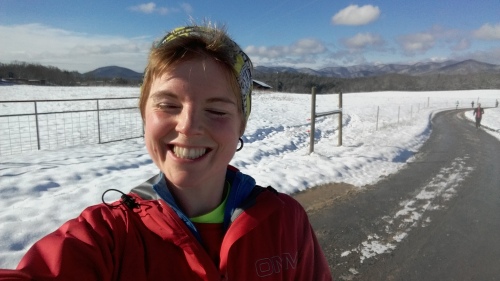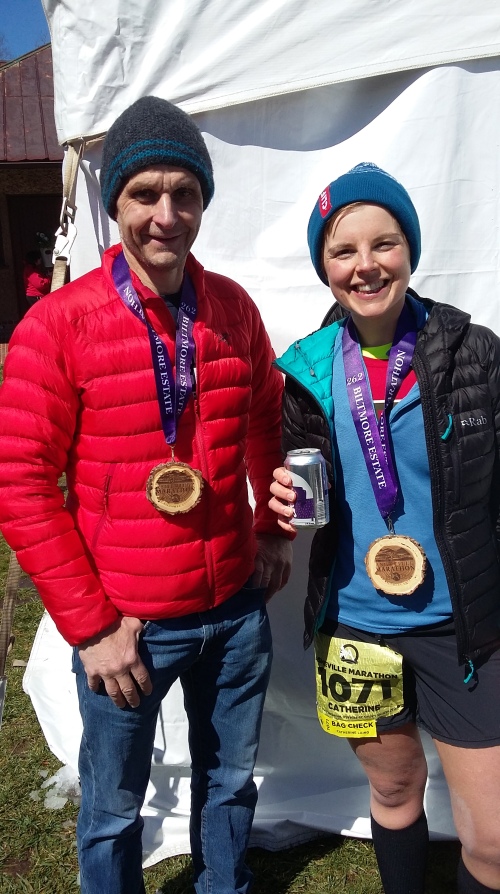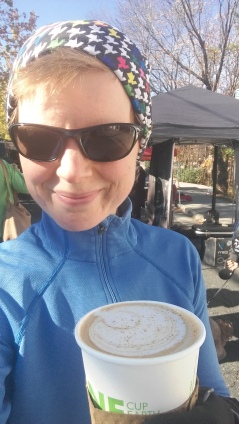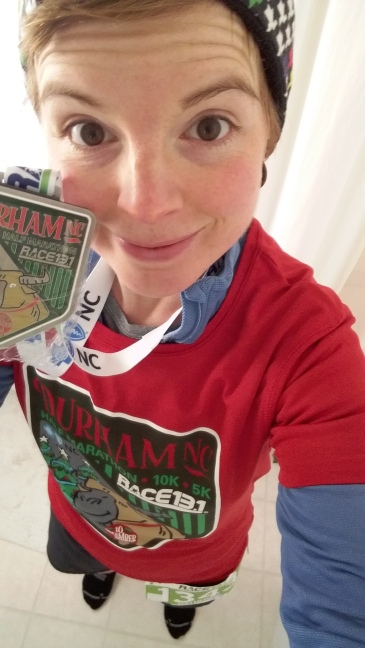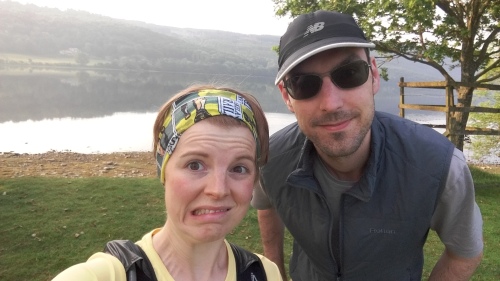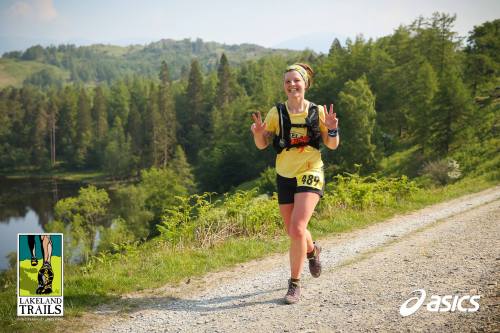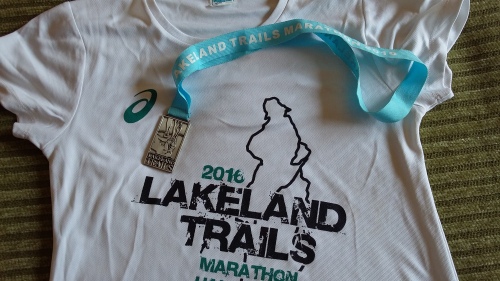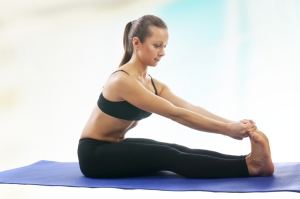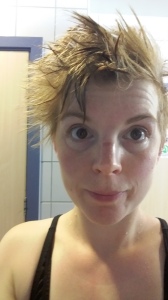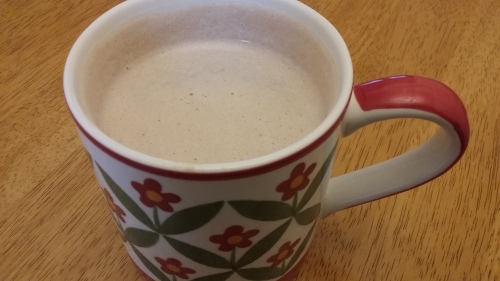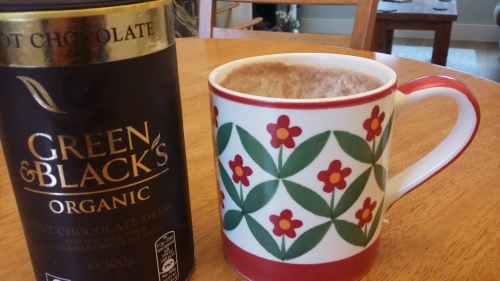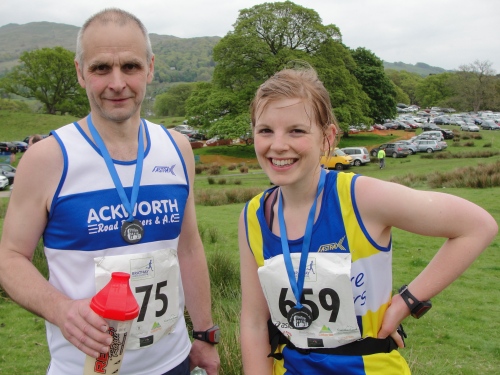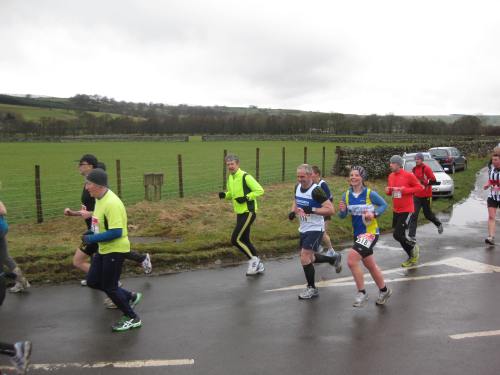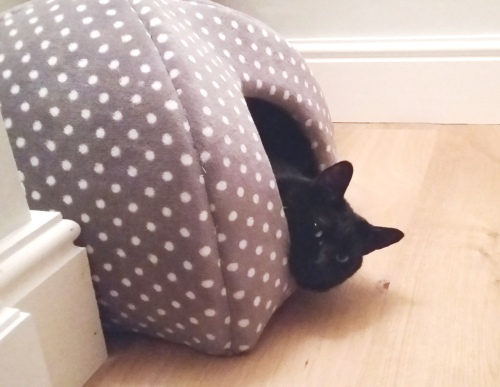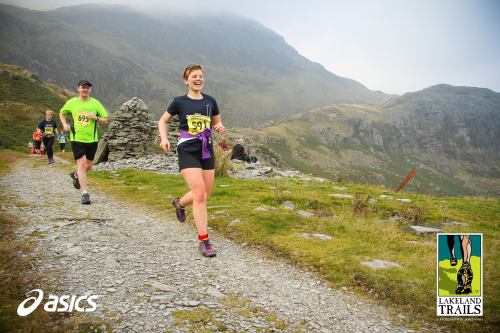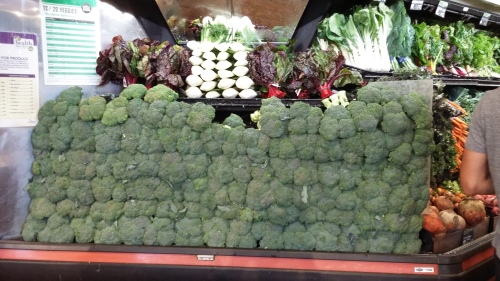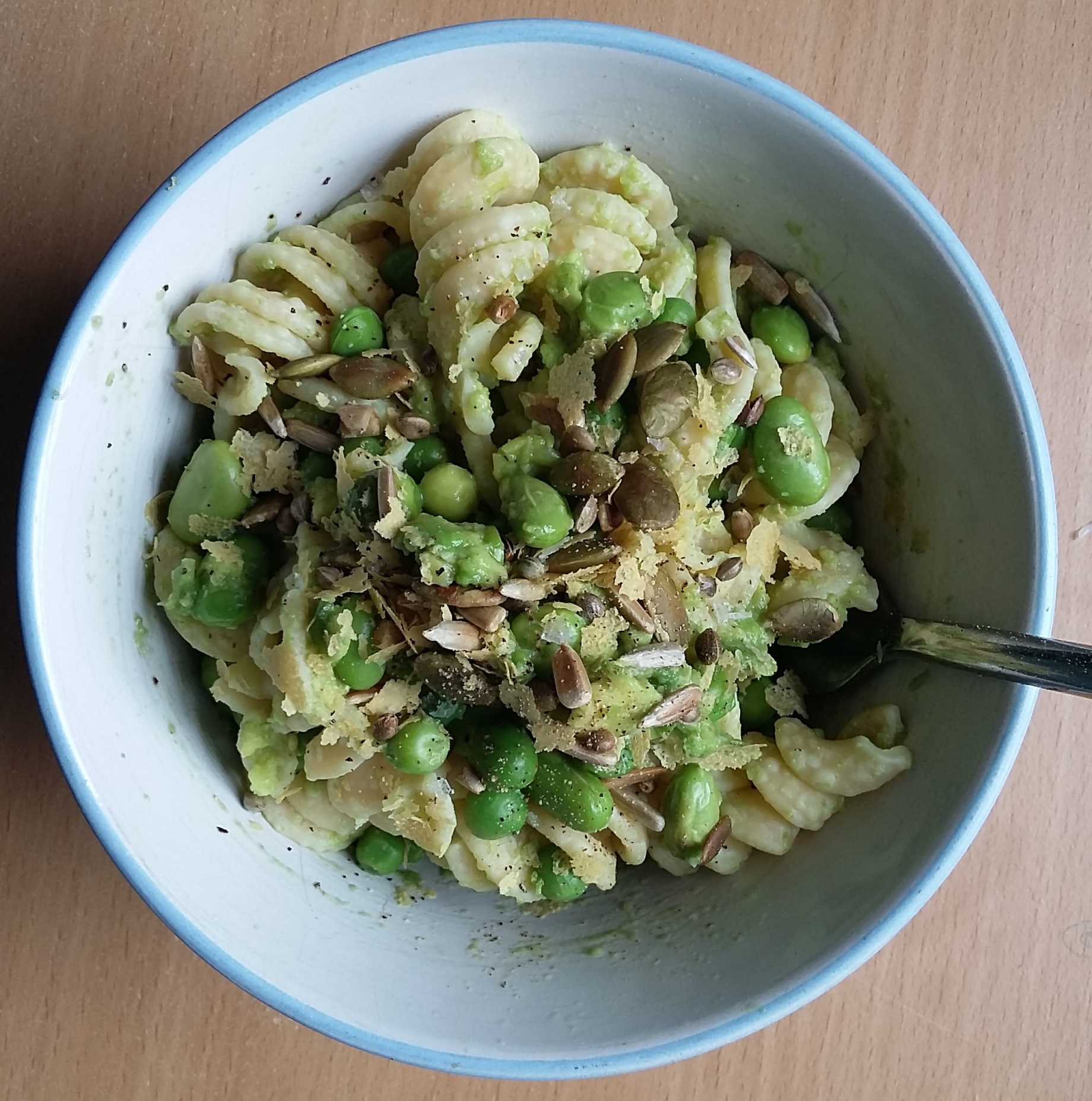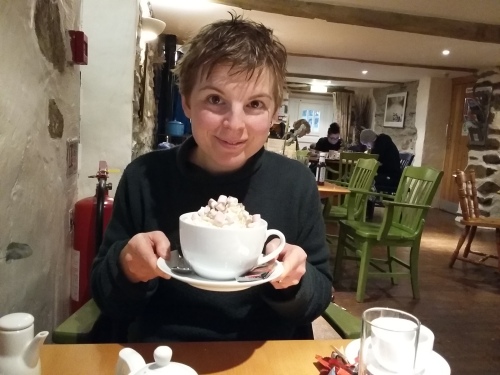I signed up to run the UT55 again this year because I wanted to go back and do a better job. I wanted to train harder; to turn up to the start fit and well-prepared, with hindsight from 2015 and a more recent recce of the route under my belt. When I signed up to this race, I was under the impression that my first attempt had somehow gone badly, and that I hadn’t yet earned the rights to call myself an ultra runner, not really. I wanted to go back to that course and earn those rights.
Not one aspect of my training went properly to plan. I started too early and peaked too soon. I say peaked, but really there was no peaking – the long runs were the worst I’ve done for any long-distance race, and unlike last year, I never felt ready for marathon+ distances; every week I finished my long run with less confidence then when I started. I didn’t manage a single recce of the route despite numerous weekends in the Lakes. Various health issues got in the way of my training, and after a really difficult time on the marathon – planned as my final long run and a pre-ultra confidence booster – I had to reassess my intentions for the race. I considered dropping out and almost committed to it on a couple of occasions, but decided instead to enjoy what I could of the amazing route, knowing that Daniel would be around the course and ready to collect me should it be required.
The day before the race I was resigned to not finishing. I was sad that this wouldn’t be my time, but also had to acknowledge the fact that my health was the priority, and that I could come back another time when I was in better shape to put in the right sort of training [Note: I did train, and put in a lot of miles, but anaemia got in the way and my fitness didn’t seem to improve one bit]. We arrived at Ambleside that evening, and the place was absolutely heaving. I was feeling incredibly negative and the hoards of people and queues of cars only added to my bad mood. After checking in and getting some stuff together I headed out to get my racepack checked – without the mandatory kit, runners would be disqualified from the race. It was here, in the prerequisite stage of the UT55, that I found my first really positive focus. The lady who checked my bag is a familiar face on the Lakeland Trails scene, and we’ve often said hello on previous events. She asked how I was feeling and, rather than giving her my entire life story, I told her I was nervous (which I was, very much so). It turned out that she had been ill for six months, and despite desperately wanting to run the race, she wasn’t able to. She reminded me to be grateful of the fact I was there at all; at the very least, I was healthy enough to give it a good go, and I shouldn’t take that for granted. This was probably the most helpful thing that I could have heard at that moment – I promised her that I’d think of her at the top of Grizedale Hause. I didn’t tell her that I wasn’t sure I’d get that far.
Ultra day came, and the weather kept to its promise. The skies were dark and heavy, and the rain was already pouring when I first dared to peep out of the curtains that morning. MWIS promised us wind, hail, and a strike of lightening or two just to add to the challenge. My dad texted me from over halfway through his 110km run to let me know that it was cold; I packed an extra base layer and decided to set off in my rainproof – combining anaemia with hypothermia didn’t seem like a good idea, no matter how much I hate running in a coat. The start line was quite subdued, but Graham spoke some really helpful words as we gathered and I remembered that this wasn’t about running, it was about moving forwards. I also spotted an incredible dog (maybe a mix of husky and bear?), which the owner kindly allowed me to pet for a while. Anything to calm my nerves. We set off in the rain, and, for the first time in days, I actually felt ok.
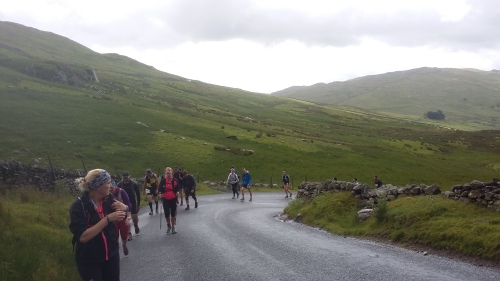
The Struggle to Kirkstone Pass
I had a race plan and I stuck to it. Keep moving. Run whenever possible (even the uphills if I feel able to). Walk fast when I can’t run. The second most important thing: EAT. The first most important thing: talk to people, receive and return positive energy wherever possible. I look back at the marathon and last year’s UT55, and on both occasions I wouldn’t have made it without the help of others. Acknowledging this was key to a good race.
I don’t need to go into too much detail about the various sections (check out last year’s post for more detail about the actual course), but what I do want to say is that I ran a very good race overall. Despite all of the things that got in the way, both in training and on the day itself, my race strategy – mainly my eating and my sharing of positive vibes – was absolutely on point. I really did run as much as I could, and it worked. Running felt so positive, so it helped me keep my spirits up, and converted more positive energy into movement. My body held up incredibly well, and I had hardly any aches and pains until the very last couple of miles, but even then it was minimal. As expected, I walked a substantial amount, but mainly this was walking in the form of ploughing forwards. Later in the race I had to remind myself to walk fast as it didn’t come naturally after hours on my feet, but again, it generated positive vibes. Constant forwards motion was very helpful – I spent no more than a minute or so at the two main check points where Daniel was waiting (enough time to refill bottles and food supplies and grab a quick kiss), and passed all of the others without stopping. My eating was carefully timed thanks to the help of baby food sachets. There’s a useless amount of calories in them, but they’re very easy to take on and keep in place – I had baby banana porridge at mile 3, which meant that my stomach wasn’t empty and acidy at mile 7, so it was much easier to take on solid food. I ate baby food tactically, filling in gaps where I didn’t actually need food, but keeping my stomach lined at all times ready for when I did. It worked wonders.
It was on the enjoyable ascent of Grizedale Hause that, for the first time since March, I allowed myself to believe that I might finish; only 12 miles in – it seemed like a risky thought to be entertaining so early on. The rain was pouring, and as we reached the top the winds were so strong I was almost knocked off my feet. There was also hail, and it hurt. As I passed Grizedale Tarn the winds subsided and the sun came out, there were no other runners in sight and everything was completely still and silent. I was truly lucky to be there, totally exhilarated, fit and able enough to trek/run 15 miles over such difficult terrain. I thought of the lady at the bag-check, as promised, and sent some positive energy her way.
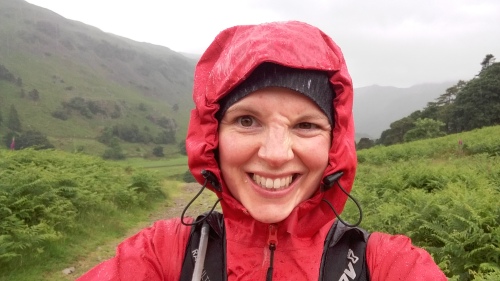
Heading up towards Grizedale Hause in the rain
While I’d made it up the hardest ascent with a spring in my step and a smile on my face (very different from last year), it was the descent that I was worried about. Descents are my weakest point by far, quickly transforming me from feeling positive and powerful up the hill to being a nervous wreck who’d happily take a cable car back down. The weather made this one all the more challenging – it was slippy and the noise of the wind was disorienting. I focussed on getting down steadily and promised myself that I’d push forwards quickly to Grasmere once I got to the road section, but all plans were soon scuppered when I found myself on my bum, screaming out in pain, worried (just for a moment) that I might have done some serious damage. I looked up and a group of helpful runners were surrounding me – they looked quite worried too. The lovely lady who I’d been chatting to helped me out and reassured me that I was ok, and so I set off on my way, feeling at best demoralised, at worst injured, and definitely as if I might not be able to carry on beyond Grasmere. Well, spoiler alert: I did carry on, but it hurt a lot. My right bum cheek was (and still is) very badly bruised, and it hurt to move, never mind to run. Daniel checked me over in a car park at Grasmere, by which point a swelling had started to appear – the jury was out on whether I was ok to carry on or not, but my back felt ok and I was determined to give it a go. Just as a disclaimer, I already had my sensible hat on at the start of the race and continued to wear it throughout; I absolutely don’t think it’s ok to run through injury if the running might make the injury worse, but in this case I didn’t think it would be exacerbated by continuing on the race.
So, back to my awesome race strategy, which had been scuppered slightly by the fact that it hurt to run, because running made my bum jiggle around. It did at least make for some good jokes, and a number of people shouted ‘How’s your bum?’ to me as we passed. One lady offered to firm my jiggle up with some rocktape, and a marshall suggested that I use a Buff as a bum-holding device. So here we return to the first most important thing: with or without the injury, as usual it was the other people around me who made this day what it was. I met so many amazing people, many of them tackling their very first ultramarathon, some of them seasoned to the graft, familiar with the challenge of long days out in the wilds. A number of people were also signed up for the Lakeland 50 four weeks later – I wish all of you well! We laughed and joked our way around, sharing low points and positive energy wherever necessary. For me, the hardest part of the day was a long section around mile 26 when I was completely on my own. I couldn’t see anyone ahead or anyone behind, and the yellow flags which marked the route were my only comfort and company. As mile 26 arrived I felt a surge of tiredness so strong that I wanted to lie down in the rocks and sleep. Fearful that my anaemia was hitting and would lead to heart failure and I’d die in the rain and mud on my own in the fells, I tried to sum up some positive energy. I came up with a single positive thought – how depressing. I decided instead to sing, but couldn’t even make it past the first few lines of my favourite Green Day songs. Clearly my thinking mind had shut down in order to conserve some precious energy; I commanded myself to ‘WALK FAST!’, and managed to catch up with two ladies ahead who I stuck with for some time. Positive energy restored; Operation: Complete Ultra was back on!
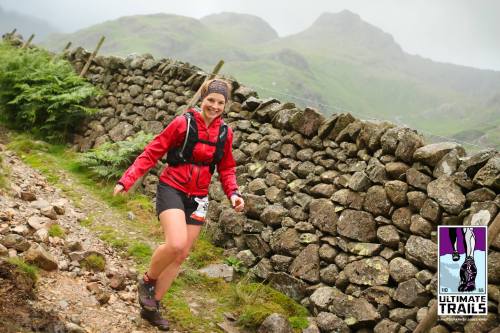
As I mentioned, my body held up amazingly. As I ran in to the final checkpoint at mile 31, a number of people commented on how fresh and lively I looked. Bum pain aside, I felt fresh and lively – my body felt great, which made the bum pain a little more frustrating than it might have otherwise been. But no time to dwell on that. By this point the light was starting to fade, which provided simultaneous motivation to press on quickly and the ultimate in Lakeland running awesomeness. After 16 miles of painful movement (and 15 miles of comfortable movement before that), I finally managed to put the discomfort aside and focus on the last 5 miles. And with this, I was about as happy as it is possible to be: running, in my favourite place in the world, the dusk chorus just starting up, the most beautiful pale light all around, running through empty fields and past still tarns, knowing that in a couple of miles I would have completed the UT55 for the second time, against all of my expectations. I didn’t want it to end quite so soon – I desperately wanted to hold on to those last few miles for as long as I could, knowing that I wouldn’t be back running in the Lake District for a long time.
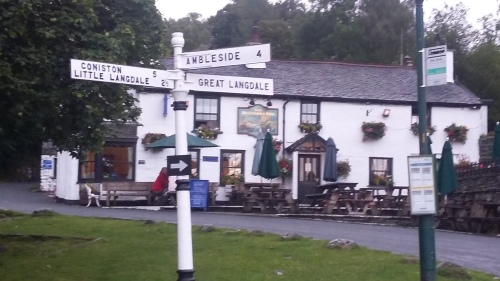
Only four miles left!
With that, the sharp descent into Ambleside appeared and I crossed that finish line. Unlike so many of the finish lines that I’ve crossed over the past 12 months, this one brought the ultimate in joy and pride. I’ve typed and re-typed and re-typed a number of sentences to follow that one, but perhaps if you are a runner (or indeed any other sort of person) and you’re reading this then you’ll know what I mean without me having to explain. The fact is that I didn’t need to have another go at the UT55 because I didn’t go a good enough job the first time around – I was already an ultrarunner (if that’s really so important anyway) before I crossed the finish line. In fact, I was slower this time, by a good hour; I didn’t necessarily do a better job – those who care only for time on a watch might say I did a worse job the second time around. But it doesn’t feel like that – I genuinely feel that I excelled myself that day, in numerous awesome ways. Getting to the end and acknowledging that I’ve done something really, truly difficult, and that I actually enjoyed myself while doing it is the best outcome I could have hoped for. Other people might run further or faster, but what anyone else does is totally irrelevant: as the saying goes ‘it is not the mountain we conquer, but ourselves’.
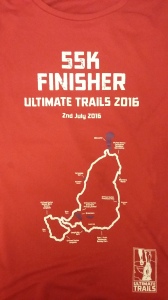
And my bum? What was a small swelling at Grasmere ended up looking like I had a banana planted underneath my skin by the end of the race, and certainly horrified the sports massage therapist two days later. I won’t be posting a photo. I got checked over by my doctor on the return home, and aside from a bruised coccyx everything is in working order. Unfortunately, I now want to return to the UT55 when I get back from living in the USA to see if I can manage it without damaging myself on Grizedale Hause – the challenge awaits!
